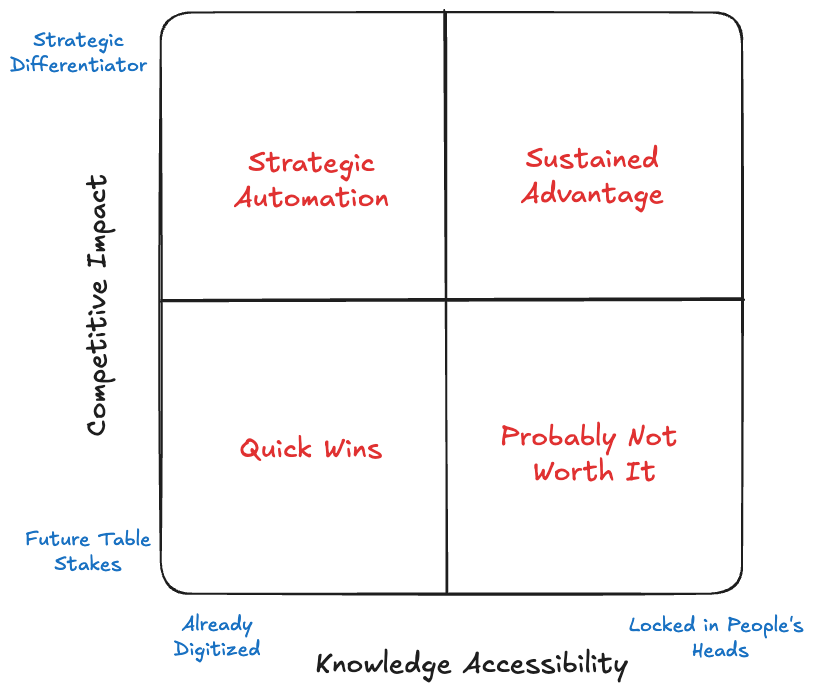Anthropic recently released a study packed with insights about AI adoption globally, in the US and in business. One finding stands out: businesses successfully deploying AI for complex, high-value tasks are feeding it dramatically longer contextual inputs than businesses using AI for simple automation. In other words, if you want AI to do anything other than simple automated tasks, you have to give it high-quality information and data in a way that can easily be accessed.
The technology works brilliantly when you can give it the right information. However, the Anthropic report highlights that the most valuable operational knowledge isn’t sitting in any system or neatly structured database. It’s locked in your experienced people’s heads. And, they might not be particularly motivated to let it out – especially given all the headlines of how AI is going to replace jobs across the workforce.
So, is your tacit institutional knowledge worth the investment to access—and can you actually get your people to share it?
Think about your most experienced people. Your sales director knows which customers are genuinely growing versus just making noise. Your operations manager understands why certain supplier relationships matter beyond the contract terms. Your senior research scientists understand exactly where the real technical risk lies in a new product launch.
None of this knowledge sits in your systems. The Anthropic research explicitly notes that workers with this kind of organizational knowledge may likely see rising demand precisely because they can provide the context that enables AI to generate real value. And generating real value is a real problem right now – something I cover in my recent article Digging Into MIT’s 95% AI Project Failure Rate – How to Increase AI project ROI.
So here’s the conundrum: how do you get your experienced people to document the expertise that makes them so valuable? You’re essentially asking them to reduce their job security by training their potential replacement. That’s not a knowledge management challenge. That’s an incentive problem most executives haven’t thought through. The simple framework that follows, helps organizations better understand where they might want to invest time and resources to access tacit knowledge that can greatly increase the value AI can generate – and how to go about doing it.
A Framework for Targeting Real Value
Working with leadership teams on AI adoption, we use a simple framework mapping two dimensions: Knowledge Accessibility (is it in your systems or people’s heads?) and Competitive Impact (sustained differentiator or future table stakes?). This creates four quadrants:
Quick Wins: Document processing, compliance automation, basic analytics from existing data. Do these first—they fund everything else and build confidence.
Strategic Automation: Customer analytics from existing CRM data, supply chain optimization from current systems. Prime territory for competitive advantage without knowledge extraction headaches. The catch? Your competitors can replicate this once they figure it out.
Probably Not Worth It: Automating niche processes requiring tacit knowledge but delivering marginal value. Skip these.
Sustained Advantage: Sales qualification using veteran reps’ customer insights, technical troubleshooting using senior engineers’ pattern recognition. This top-right quadrant is where the Anthropic study’s most successful companies operate.

Quick Self-Assessment:
Think about your current AI initiatives. Where do they sit on this framework?
- Mostly Quick Wins? You’re not alone—but your advantage expires in 18 months
- Some Strategic Automation? You’re ahead of most, but competitors can replicate
- Any Sustained Advantage plays? You’re rare—and likely solving the incentive problem
Here’s the problem with staying in Quick Wins territory: there’s so much low-hanging fruit today that you probably don’t need tacit knowledge to achieve competitive advantage. Yet. But every organization is reaching for the same fruit. Within eighteen months, simple automation becomes table stakes, not differentiators. When your competitors have automated the same processes, you’re back to competing on the same factors you always did.
That’s when organizations that invested in the top-right quadrant separate from the pack.
The Anthropic data reveals another interesting insight: businesses successfully deploying AI for complex, context-heavy tasks aren’t worried about AI ‘compute’ costs. When you can actually feed AI the right contextual knowledge, the value generated is so substantial that technology costs become irrelevant. These organizations aren’t optimizing for cheaper deployment—they’re capturing value simple automation can’t touch.
But getting there means solving that incentive problem. It means systematically interviewing experienced staff and documenting decision frameworks. It means capturing the “why” behind processes, not just the “what.” It means building knowledge bases that translate institutional memory into something AI can use. Most critically, it requires ongoing investment—this isn’t a project with an end date.
Having led innovation teams across energy, chemicals, and health sectors, I’ve watched organizations invest millions in promising software solutions and, more recently, AI, while their most valuable knowledge remained locked in senior people’s heads. The organizations that broke through weren’t the ones with the best technology—they were the ones that solved the incentive problem first, making knowledge capture feel like career development rather than career risk.
The competitive advantage in AI won’t come from having the best models—everyone has access to the same technology. It’ll come from having the best context to feed those models.
So before you approve another AI initiative, answer this honestly: Where do your opportunities sit on this framework? Are you content staying in Quick Wins territory, accepting your advantage has an expiration date? Or are you willing to reach the top-right quadrant—making institutional knowledge explicit and solving the incentive challenges?
Because if not, stop pretending you’re going to get sustained strategic value from AI. You’ll get tactical efficiency gains, which might be enough. But the organizations extracting real competitive advantage are treating knowledge infrastructure and employee incentives as seriously as technology infrastructure.
Your choice. And theirs.
Download the AI Opportunity Framework
4-page strategic guide mapping Knowledge Accessibility × Competitive Impact. Learn where to invest in AI for sustained advantage vs. quick wins. Based on Anthropic Economic Index analysis.
